
The History of Yakuoji from the Kamakura Period

Yakuoji is an old and historical temple that was established in the Kamakura period (1192 – 1333).
In this section, you will discover the history and relationship between the historically well-known Tokugawa Family and this temple.
See the above picture
In October 1282, Nichiren (one of the most famous religious leaders in Japan) was sick in bed and called Kyo Ichimaro, a 13 year old pupil, to his bedside. The boy who was highly prized by Nichiren was ordered to spread his teachings in Kyoto.
Nichiren Shu Buddhism was still only a new risen religion at that time.
It was quite obvious that a lot of difficulty would be waiting for them. The boy, though, was prepared to suffer hardships and departed for Kyoto.
After one hundred days of austere practices at Yuigahama, Kamakura to bear persecution, he arrived at the present site of Yakuoji in 1293.
There used to be a temple in Shingon Shu Sect Yakoji at the site. Young Nichizo Shonin argued against the chief priest of the temple and converted him and the temple to Nichiren Shu Sect.
Yakoji declined afterwards but Nittatsu Shonin restored and renamed it to Yakuoji.
People Deeply Connected with Yakuoji and its Memorial Tombs
Tokugawa Tadanaga, the younger brother of the third shogun Iemitsu, was confined to his residence because of his bad behaviors.
His memorial tomb is also in the precincts of Yakuoji.
His father was the second shogun of Tokugawa shogunate (Tokugawa Hidetada) but he hunted in Mt.Asama, a sacred mountain, where killing animals was prohibited.
He also killed his servant page just because he took long to make fire.
He was imprisoned for his crimes, where he killed himself by stabbing in his own throat.
His wife Shokoin, a granddaughter of Oda Nobunaga, built the memorial tomb and many other halls for him with vast amount of donations.
There are graves of Shojuin and her daughter in the temple precincts.
Shojuin is a granddaughter of the first shogun Ieyasu and the wife of Gamo Tadatomo (a feudal lord).
It shows the deep relationship between the temple and the Tokugawa family.
Because of its deep connection, Yakuoji was allowed to use the family crest of the Tokugawa Family (mitsuba-aoi).
Due to its high social status, ordinary people were not permitted to lay their ashes in this temple.
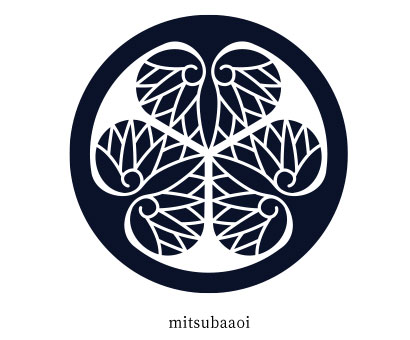
Access
| Address | 3-5-1, Ogigayatsu, Kamakura City, Kanagawa Prefecture |
|---|---|
| Access | 16 minute walk from the west exit of Kamakura Station of both JR Yokosuka Line and the Enoshima Electric Railway |
| pening hours | 09:30 to 16:00 |
| Day closed | None |
| Entrance fee | None or small token |
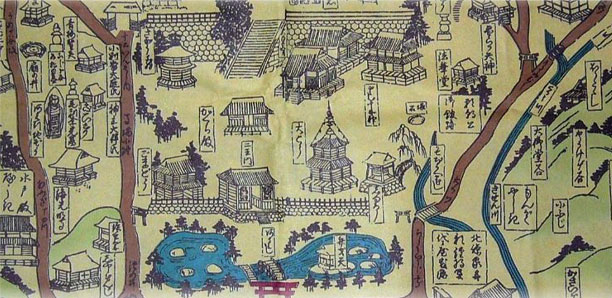
The Connections with Tokugawa Family
In the center of the main hall is the Seated Statue of Nichiren Shonin, which used to be enshrined in the main hall of Nezumiyama Kannoji. Kannoji was founded by the 11th shogun Tokugawa Ienari to pray for the peace and stability of the Tokugawa Family.
The statue contained his ashes inside.
(Nezumiya was situated around current Meguro, Toyoshima ward, Tokyo)
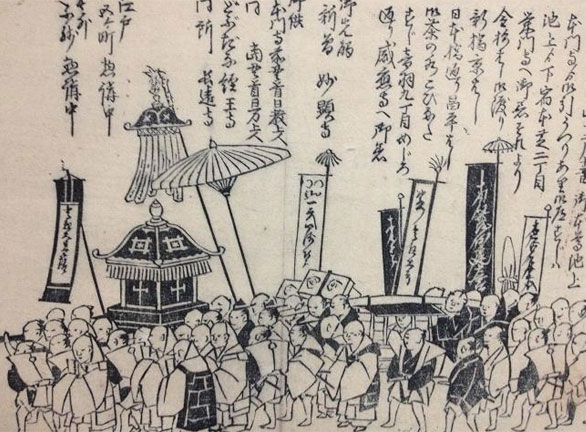
This picture scroll depicts the grand procession when the statue was dedicated to the main hall of Kannoji.
The statue was placed in the portable shrine (the above picture).
Kannoji was abolished during the Tenpo Reforms conducted by Mizuno Tadakuni (senior counsel) to improve the financial situations.
In those days, the shogunate faced financial difficulties. The statue was transferred to Yakuoji.
The memorial tomb in the right side of the precincts is related to the Tokugawa and Oda Families. It has been designated as cultural property by the Kamakura City.
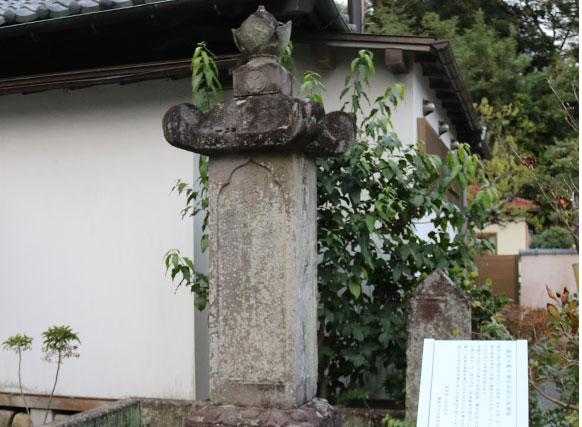
The tomb was built by Shokoin, the wife of Tokugawa Tadanaga (the younger brother of the third shogun Tokugawa Iemitsu).
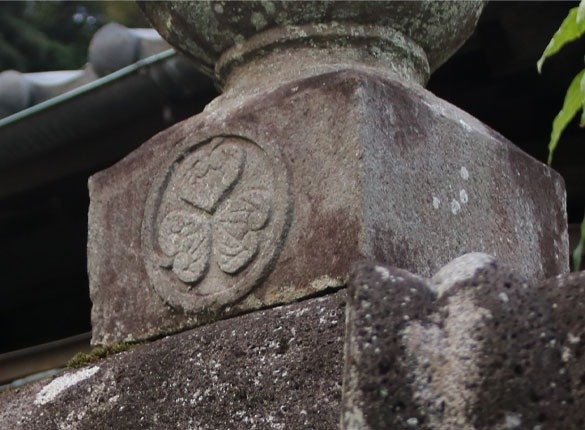
In addition to her own Buddhist name, the names and seals of her husband, parents, brothers, and the past chief priests of Yakuoji are inscribed on it. It is estimated to have been built between 1688 and 1704. The stand for necrology and the stand for Kei (ringing instrument) dedicated by her are the temple’s treasure.
Hokyoin Stone Pagoda: The Graves of Gamo Tadatomo’s Wife and Daughter
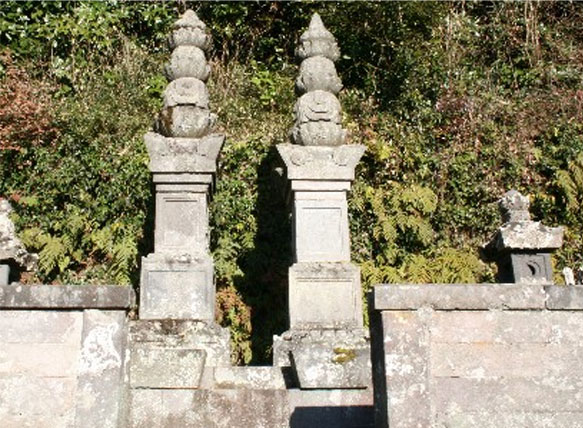
The huge stone pagoda shows the history of more than 300 years.
In the old cemetery of Yakuoji are the graves of Shojuin (who died at the age of 89 in 1700) and her daughter (who died at the age of 12 in 1645).
Shojuin was the wife of Gamo Tadatomo, who was the feudal lord of the Matsuyama Castle in Shikoku.
About the Gamo Family
Shojuin and Baireiin
Shojuin is the seventh daughter of Naito Masanaga ( the feudal lord of Iwakidaira).
Her secular name is unidentified.
She married 23-year-old Gamo Tadatomo at the age of 13. Her first son Tsurumatsu (the heir) died at the age of three in 1633.
When her husband Tadatomo died, she was 20 years old. She was pregnant and gave birth to a girl. If it had been a boy, he could have succeeded to and restored the Gamo Family. Her daughter also died young at the age of 12. Her Buddhist name is Baireiin.
Gamo Tadatomo
His father Hideyuki is the first son of Gamo Ujisato (feudal lord of Aizu Domain).
His mother is Princess Tatsuhime, the third daughter of Tokugawa Ieyasu (the founder of Tokugawa shogunate).
It is said that his father died a sudden death due to a disease when he was sent to Kyoto prior to the shogun Iemitsu’s visit to Kyoto.
His elder brother Tadasato died in 1627 without a son and his heir Tsurumatsu died young. As a result, the Gamo Family became extinct.
Tadatomo died at the age of 30 in 1634.
Tsurumatsu
It is said that he might be buried in Yakuoji but it is not certain.
He died at the age of three in 1633.
About the Chief Priest
Hello
I am Ono Jisei, the 53rd chief priest of Daijozan Yakuoji of Nichiren Shu Buddhism.
In former times, temples listened to all sorts of people’s problems and provided a proper advice to each person.
Moreover, they established a school and gave education to young people. For ordinary children, temples were the only place of
academic study.
“Whenever in trouble, go to temples!”
“Let’s consult our priest to solve this problem.”
“Leave children’s discipline to our priest.”
“Our priest will make it alright.”
These were the common images people had in their mind about temples and priests.
Priests acted as a judge, a doctor, a lawyer, or a school teacher, depending on the situation.
That’s why temples were called a shelter for refugees.
People rushed into temples whenever troubled.
However, the roles of temples have changed significantly after the Meiji government enforced anti-Buddhism policy and
established the parishioner system.
It is said that many people got together at this temple to pray, ask for advice, or study.
What a temple should be is a shelter for refugees. Now we are trying hard to retrieve the original images of temples in the old days.
Needless to say, we hold regular services for departed souls with all our hearts.
If you have something to talk about or if you need advice, please come and see us in Kamakura.
Praying hands for you.
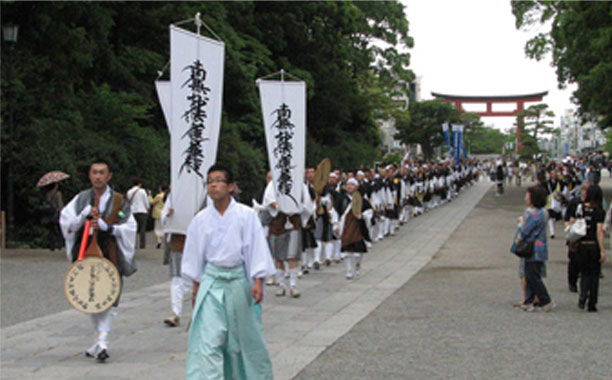
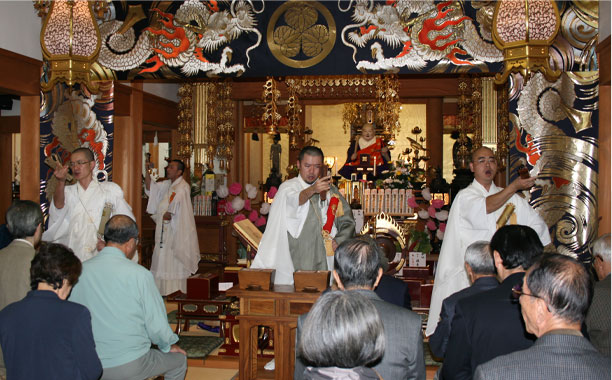
| Name | Ono Jisei |
|---|---|
| My Motto And Favorite Words | “You should be ashamed of being praised by fools.” “Be born again in your current lifetime.” “What goes around comes around.” |
| Person I admire | Ono Jinen, the fifty-first chief priest of Yakuoji Hayami Nissho Shonin, the eightieth chief priest of Kamakura Myohonji. |
| Hobbies | Baseball, drums (retired due to frozen shoulder) |
| Favorite sports to watch and cheer | Baseball, American football |
| Favorite sports players | Ichiro, Matui Hideki, Barry Sanders (American football), Michael Jordan, Scottie Pippen (basketball) |
| Favorite singer | Nakajima Miyuki |
| Favorite song | Tanjo (Birth), Omoki niwo seoite (Bearing a Heavy Burden) by Nakajima Miyuki |
Buddha Statues of Yakuoji
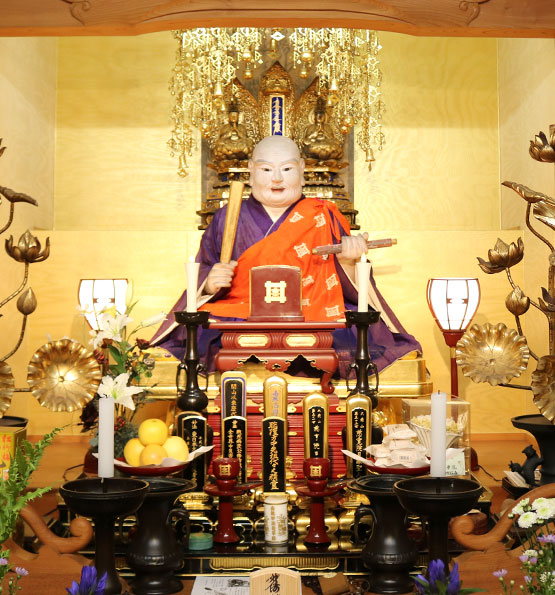
Seated Nichiren Shonin, wood
The statue keeps the mouth open with a scepter in the right hand and a sutra scroll in the left hand.
This type of statue is rarely seen.
A cloth is draped over the naked upper body with the nipples exposed.
There is a rectangular hole in the lower back. The ashes of the 11th shogun Ienari are said to have been placed inside through it. The statue wears a real stole and robe.
According to the record of the temple
According to the record of the temple
The statue was originally enshrined at Kannoji in Nezumiyamahe temple was constructed during the period the 11th shogun Ienari by the Tokugawa shogunate. Though it had magnificent and graceful buildings, it was abolished, and later the buildings were split apart after he passed away. The sacred statue survived the destruction, and was transferred to this temple through Honmonji and Myohonji.
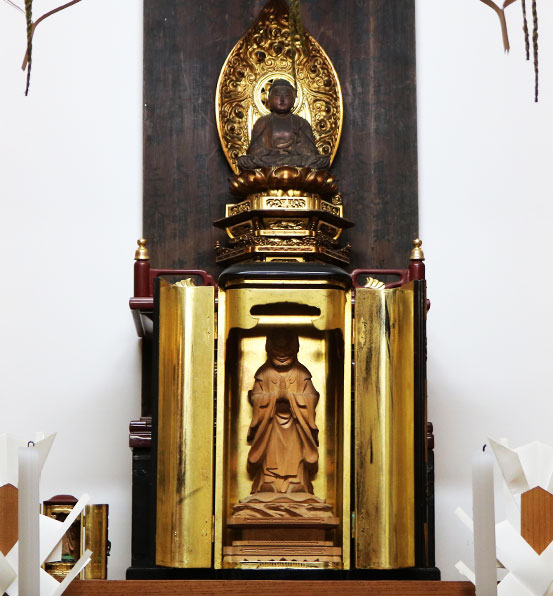
Demon-Shaped Kishimojin(Child Goddess), Wood
Placed at the Acetic Exercise Hall, Showa period(20th century),
Height:34cm, single-block construction.
It was carved by Nikko, the 52nd chief priest when he practiced ascetic exercise services in the Acetic Exercise Hall. Nissei the 53rd also brought it into the ascetic hall of Enjyuin temple when he engaged in the rigorous services. There are only two ascetic halls in Nichiren Shu Sect.
Kishibojin was originally a demon who ate human beings but preached by Buddha, became a guardian deity and saved the people reading the Lotus Sutra.
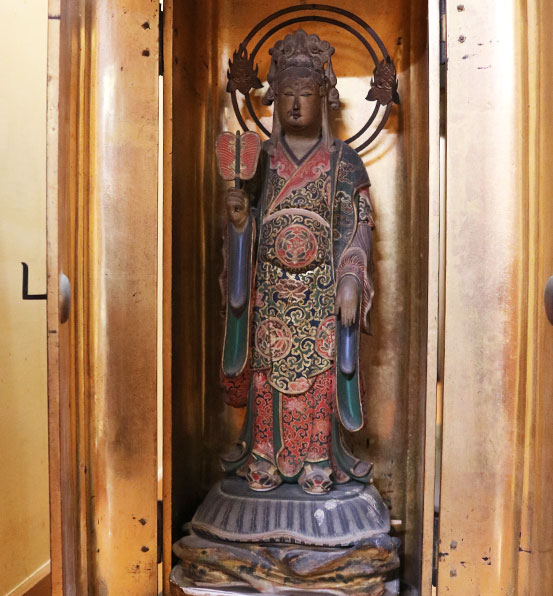
Standing Atsuta Daimyojin, wood
Head: made in China, Body: Edo period,
Height: 34cm
Atsuta is the first one of the 30 guardian deities. Considering that daimyojin statues usually stand with other guardian statues, this single existence of the statue is a rare case.
It is dressed in the apparel of Taoism with a rounded fan in the left hand. The head is made of ceramic (very rare). Judging from the figure of the crown and its facial features, it is thought to have been made in China.
The monogram of Nikkyo Shonin is written on the back side, which indicates he had the body of the state made. He passed away in 1718.
The records of the temple say the head excavated from the temple grounds glowed at night. Yakoji (Shine in the Night Temple) is named after this legend.
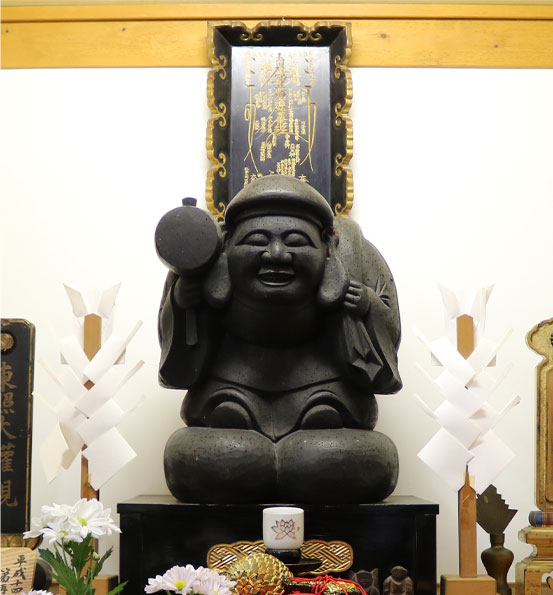
Standing Atsuta Daimyojin, wood
Edo period(1839), height:43.5cm
Colored in black, Indian Ink inscriptions at the bottom of the statue
Made by Nichiryu Shonin, the chief priest of Jissoji , later handed over to Nissho Shonin, and then transferred to this temple by him.
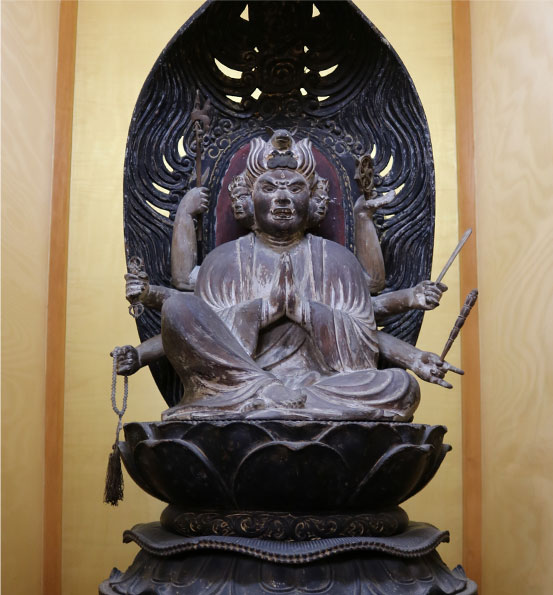
Seated Bato Kannon Bosatsu in the Half-lotus Position
Muromachi period(14th-16th centuries),
total height: 95cm, statue height: 88cm
Donated in the Edo period. Unlike other five kannon statues, Bato kannon has a fierce face. This is the only Bato kannon statue you can find in Kamakura.

